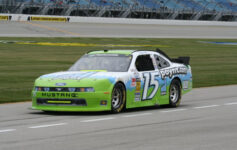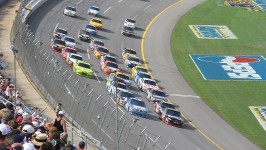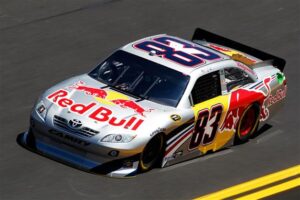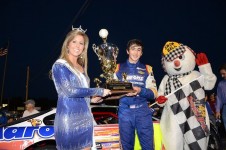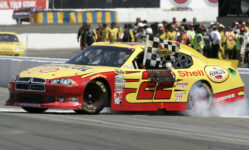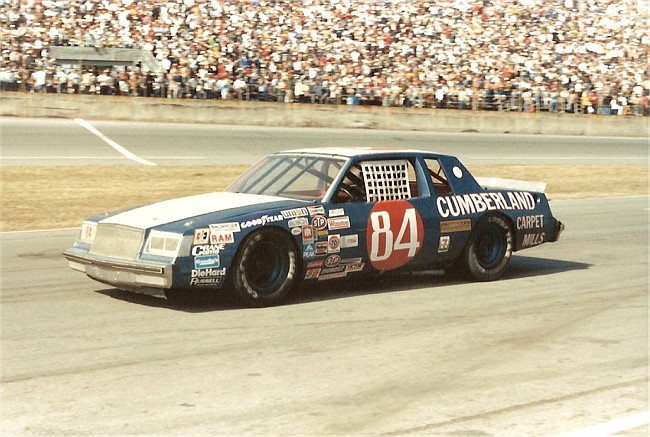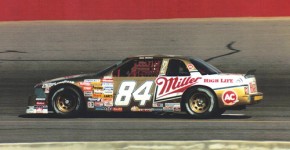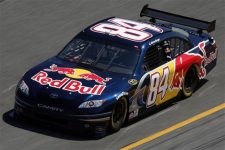Daytona: “You just know. After 30 years of doing this, I know.” — Tony Stewart
[media-credit name=”CIA Stock Photo” align=”alignright” width=”227″]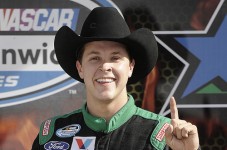 [/media-credit]The season started with a photo finish between Clint Bowyer and Tony Stewart with the margin of victory being 0.007 seconds. But Stewart says he knew that he had won before NASCAR relayed the official timing. The victory was the fourth straight for Stewart in the event.
[/media-credit]The season started with a photo finish between Clint Bowyer and Tony Stewart with the margin of victory being 0.007 seconds. But Stewart says he knew that he had won before NASCAR relayed the official timing. The victory was the fourth straight for Stewart in the event.
Phoenix: “I think from last year I owe Kyle one little bump and I thought about taking it but it’s a new year and I thought I could get by him clean.” — Carl Edwards
The two dominant drivers in the NNS have to be Carl Edwards and Kyle Busch. At Phoenix Busch led all 200 laps on his way to victory as Edwards did his best to steal it at the end. While he says he owed Busch one from 2010, Busch said in victory lane he didn’t know what Edwards was talking about.
Las Vegas: “I just decided I wasn’t going to run out of gas.” — Mark Martin
Mark Martin wasn’t supposed to be in victory lane at Vegas but the wheel hit the No. 32. Martin stole the win as Brad Keselowski hit the wall on the final lap. The win helped Martin stay ahead of Kyle Busch as the all-time wins leader before Busch tied and broke the record later in the season.
Bristol: “I feel like God has given me the opportunity to race in NASCAR and I owe it to the fans, sponsors, that I am not a start and park driver. I’m here to race.” — Jennifer Jo Cobb
The green flag hadn’t even fallen at Bristol before there was drama. The short-track in Tennessee plays host to the best of rivalries but it’s rare for it to between driver and owner. Cobb stepped out of the car before the start of the race when told by the owner that she needed to start and park.
Fontana: “We stole this one, it wasn’t ours.” — Kyle Busch
The day that Busch doesn’t dominate a NNS race and win is surprising but that was the case in California. Kevin Harvick and Carl Edwards had the field covered and separated themselves for much of the day. That was until the No. 18 team used pit strategy to get Busch out front and pick up another win.
Texas: “The crowd at Texas it a little bit wild.” — Carl Edwards
No longer are backflips enough for Edwards when he wins a race. At the end of 2010 he started going into the grandstands to get up close and personal with the fans. In Texas he discovered that going into the stands was a lot easier then coming back out.
Talladega: “What a day. We just have a small crew; just a small team, trying to do what we can do week by week and we gave ‘em a run for their money today. I wish it would have ended under green.” —- Joe Nemechek
The plate tracks of Daytona and Talladega provide a great chance for a driver to shock the NASCAR world. Trevor Bayne did as much in the Daytona 500 in the Sprint Cup Series in 2011. Here though, Nemechek didn’t get the win but thought he could have for his self-owned, underfunded team had the race gone to completion.
Nashville: “Them Roush cars are just so dang fast, all of them.” — Brad Keselowski
A common theme in 2011 was the resurgence of Roush Fenway Racing and Ford. Both Keselowski and Kyle Busch found it hard to beat them and said they had an advantage. At Nashville Keselowski finished third behind Edwards and Busch.
Richmond: “Well, I guess NASCAR decided that we should be the tail end of the one lap down cars, I’m not really sure how they decided that … They’re gonna have to explain that to me” — Aric Almirola
Following a pit road speeding penalty NASCAR placed Almirola at the rear of the field. After contesting that NASCAR had made a mistake he fought back to finish 14th but still wasn’t happy about what had happened. A few weeks later Reed Sorenson would line up incorrectly on a restart, which NASCAR did not correct.
Darlington: “That seems to be my best style here at Darlington, beat ‘em up as much as you can and see if you can win with it.” — Kyle Busch
It wasn’t pretty and he certainly didn’t have the best looking car, but Busch always finds a way to win. At Darlington the track ‘Too Tough to Tame’ reached out and abused his car a few times but it didn’t help the competition stop him from winning again.
Dover: “That was pretty wild man, I thought I was going over the wall.” — Clint Bowyer
The fireworks that normally appear at Daytona and Talladega when it comes to spectacular but scary wrecks appeared in Dover this year. On the final lap coming off turn four Joey Logano got loose while racing Carl Edwards. He bounced off the wall and came down the track where Bowyer hit him and flipped on his side down the frontstretch.
Iowa: “I couldn’t think of a better place to win.” — Ricky Stenhouse Jr.
The 2011 season was that of Ricky Stenhouse Jr. From wrecking, being benched and fighting for his job in 2010, Stenhouse came back with a vengeance. He gave the Cup drivers a run for their money every week and finally broke through for his first win at Iowa – where he had wrecked in 2010 – by holding off teammate Carl Edwards and Brad Keselowski.
Charlotte: “Once I cleared Carl I waved to him like, ‘OK we got ‘em’ but then he passed me back and I felt pretty stupid.” — Matt Kenseth
With an ill Trevor Bayne sidelined it was 2003 Cup champion Matt Kenseth getting a chance at the No. 16. In a one-race deal Kenseth came in and won after putting on a great battle with teammate Carl Edwards after he nearly gave it away.
Chicago: “I got a big grin on my face from ear to ear and turned left and as soon as I got even with him, I ran out of fuel.” — Justin Allgaier
There are many arguments for and against fuel mileage races but in Chicago it couldn’t have been more exciting. Allgaier and Carl Edwards battled each other and their fuel gauges with little laps left. On the final lap Edwards ran out going down the backstretch and Allgaier ran out shortly after. Both drivers coasted all the way around to the checkered flag.
Michigan: “This track definitely needs a motor and we have it.” — Ricky Stenhouse Jr.
Leading the race with less than 10 laps to go it looked like Stenhouse Jr. was about to pick up his second career win. But teammate Carl Edwards wasn’t about to let Stenhouse have it as he took it away as Stenhouse’s car got too tight at the end. In Detroit’s backyard Edwards and Stenhouse powered Ford to a one-two finish.
Road America: “That is why [Jacques Villeneuve] should quit driving NASCAR no sense. I hope Max Papis punches his dumbass in the mouth.” — Kevin Harvick
Road course ringers are supposed to be the professionals who whip on the NNS regulars. But Jacques Villeneuve didn’t give them a good name in 2011, as he was involved in numerous incidents that prevented himself and others a chance to win. When he took out Max Papis at Road America it was the team owner of the car Papis was driving that let loose on his Twitter page.
Daytona: “Kept it straight, kept my foot in it too. I know that’s probably not the right thing to do when there’s a crash but I was going for broke in the GoDaddy car.” — Danica Patrick
Again running a limited schedule for JR Motorsports, Danica Patrick nearly won at Daytona and it wouldn’t have been a fluke. Drafting with teammate Aric Almirola and now Sprint Cup team owner Tony Stewart, Patrick led a majority of the race and was in content heading to the finish. A last lap wreck kept her from a top five finish.
Kentucky: “He’s just got to make up his damn mind up on the box.” — Kevin Harvick
Never one to hold his tongue, Harvick makes sure others know where they stand with him. That includes his team on pit road and his crew chief, who he ripped on after Kentucky following pit calls he didn’t agree with.
Loudon: “I hope some day we get to 200.” —- Kyle Busch
It took longer than he expected but Busch finally broke Martin’s record. It was his 49th career win in the NNS and his 100th across all three series. Busch hasn’t hidden the fact that he wants to win 200 races to join Richard Petty in the record books.
Nashville: “Heavenly father we thank you tonight for all your blessings. We want to thank you tonight for these mighty machines that you’ve brought before us. Thank you for the Dodges and the Toyotas, thank you for the Fords and most of all we thank you for you the Roush and Yates partnering to bring us the power we see before us tonight. Thank you GM Performance technology and R07 engines. Thank you for Sunoco racing fuel and Goodyear tires that bring performance and power to the track. Lord I want to thank you for my smoking hot wife tonight, Lisa. And my two children Eli and Emma, or as we like to call ’em, the little E’s. Lord I pray that you’ll bless the drivers and use them tonight, may they put on worthy of this great track. In Jesus name, boogity, boogity, boogity, amen!” — Pastor Joe Nelms
Quote of the year, ’nuff said. No one remembers the race after that.
Indianapolis: “Ricky really deserved to win this race with the car he had but things kind of fell our way tonight.” — Brad Keselowski
The fastest car doesn’t always win and Keselowski made sure of that in Indy. When a late race caution and subsequent readjusting of the lineup put Keselowski near the front he engaged in a hard battle with Ricky Stenhouse Jr. He used up the No. 6 just enough to get by him to lead the final seven laps and took the win after Stenhouse had nearly the entire race.
Iowa: “I was aggressive there at the end, you gotta do what you gotta do to win. I wasn’t going to let another one slip by us.” — Ricky Stenhouse Jr.
A week later Stenhouse made sure that he ended up in victory lane when he again spanked the field at Iowa. He battled hard with teammate Edwards and traded paint with him when he felt needed. The two traded barbs afterwards but Stenhouse went home with the trophy.
Watkins Glen: “It was one of those feelings like, we’re going to see this race on ESPN Classic if we could have gotten to duel it out at the end.” — Kurt Busch
When Brad Keselowski broke his ankle testing he asked Cup teammate Kurt Busch to sub for him at The Glen. Busch won the pole and dominated the race, battling with his younger brother Kyle during parts of the event. A fuel mileage race ended the possibility of the two fighting for the win late in the race.
Montreal: “Only girls pull hair.” — Steve Wallace
Another recurring theme in 2011 was that of Steven Wallace being involved in accidents. The No. 66 was constantly being torn up and in Montreal he wrecked Patrick Carpentier, who was racing in his final NASCAR race. After the race Carpentier’s crew chief got a handful of Wallace when expressing his displeasure with the move.
Bristol: “Wish I was the one in victory lane right now and not sitting over here in second by three inches.”—- Joey Logano
Never the bride, always the bridesmaid, at least that’s what some viewed Logano as in 2011. Coming up short in Bristol to his teammate in a photo finish Logano said he did everything he could to win besides wrecking Busch.
Atlanta: “I will tell you one thing: I’ll find him after the race and it’ll be between me and him.” — Reed Sorenson
When teammates wreck each other it’s never good, except for outsiders who get to watch what happens next. When Justin Allgaier wrecked Sorenson in Atlanta when Sorenson was battling for the championship, he vowed to find him after the race and settle it.
Richmond: “One of those deals and hate the way it all turned out but all in all, it’s short track racing I guess.” — Kevin Harvick
At first Harvick tried to calm that his intentional wrecking of Trevor Bayne was caused because he got loose. Afterwards though he admitted to racing hard with Jason Leffler and then Bayne who got into the back of him and was then retaliated upon.
Chicago: “I’m going to take every one of those freakin’ lapped cars and wreck ‘em.” — Brad Keselowski
Trying to make his way through the slower traffic in front of him, Brad Keselowski lost the lead to Carl Edwards midway through the race. He vented on the radio to his team but after he regrouped was able to hold off Edwards for the win.
Dover: “Fun, fun day. Just got beat, got beat up all day by Carl.” — Clint Bowyer
Unlike the first race at Dover where Bowyer was sliding on his door over the finish line as Edwards won, Bowyer was able to battle to the finish in September. Unfortunately he came up short to a very fast Roush Fenway Ford.
Kansas: “He races way over his head and he’s very fortunate that his dad has a lot of money and spends a lot of money on his racing and that’s a big factor in what he’s got going on.” — Aric Almirola
There were many highlight moments between Almirola and Brian Scott in 2011 and at Kansas the two traded more than paint. Scott accused Almirola of racing him too hard and blocking him from getting in the pits. Almirola came back and said that Scott was overreacting as always.
Charlotte: “I may give that car a kiss before I go to bed tonight.” — Jack Roush
Even after pancaking the right side of his car, Carl Edwards went on to win at Charlotte for his eighth win of the year. Team owner Jack Roush said afterwards that he couldn’t be prouder of his organization for building great racecars and rebounding for a horrible 2010.
Texas: “I don’t know if you could script a story like the year I’ve had.” — Trevor Bayne
He started the year by wining the Daytona 500 just a day after he turned 20 years and in his second career Cup start. But a few weeks later Bayne was sidelined from running for the NNS championship when he fell ill. Then in November he finally won his first NNS race after beating teammate Carl Edwards.
Phoenix: “Every 10 years, I guess, I get to come to victory lane here for the first time in a different kind of car, so it’s pretty special.” — Sam Hornish Jr.
It’s been a tough road in NASCAR for Sam Hornish Jr., who lost his Cup ride following sponsorship woes and bad performances. Not one to give up he decided to stay in stock cars and give it more time, running a limited schedule in 2011. At Phoenix he shocked everyone when he won his first race after dominating the final 100 laps of the race.
Homestead-Miami: “This is a dream come true.” — Ricky Stenhouse Jr.
The story of Ricky Stenhouse Jr. will be told for many years to come. In 2010 he wrecked more than he raced, was then benched by owner Jack Roush before getting a second chance in the second half of the season. He came back to win Rookie of the Year honors before embarking on a championship tour in 2011. Stenhouse won two races and looked like a completely different driver than who was on track a year ago.



